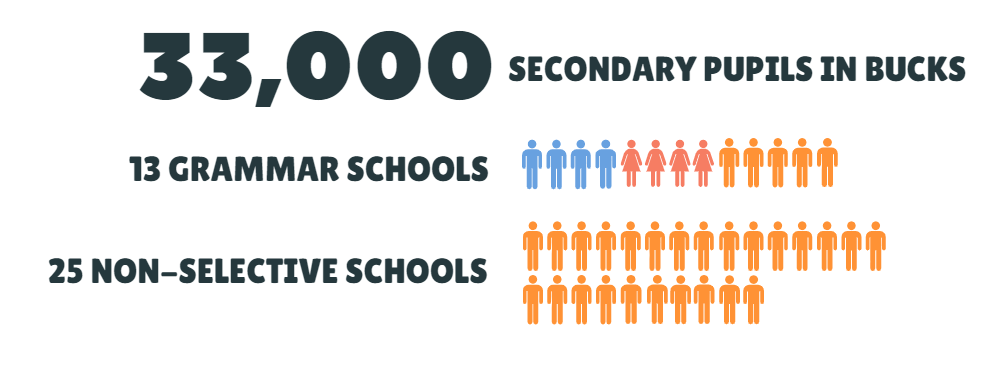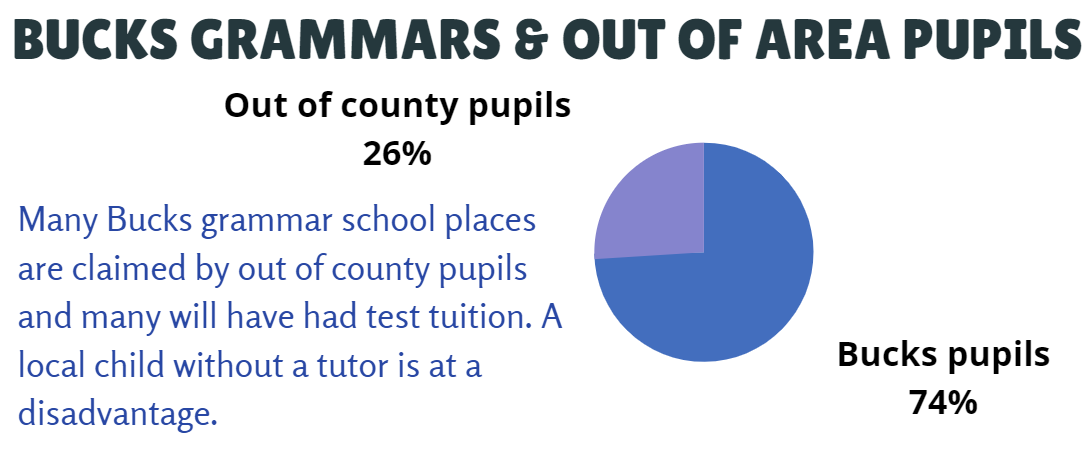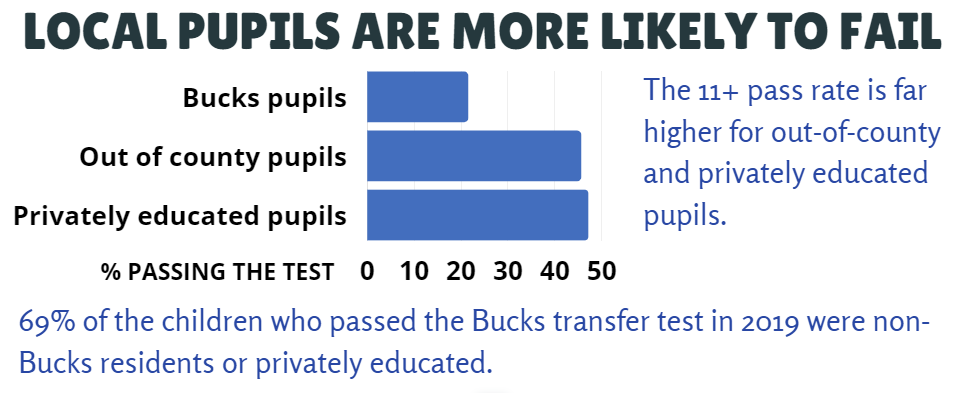 Selective education guide – Buckinghamshire
Selective education guide – Buckinghamshire
BACKGROUND
There are 38 state secondary schools in Buckinghamshire. Of these, 13 are grammar schools. Buckinghamshire’s 25 non-selective secondary schools are known as ‘upper schools’. The county also has one University Technical College which offers secondary education for 14 -19 year olds.
Check out our map of selective schools in England to find out more about these schools. The map gives the percentage of disadvantaged pupils, the percentage of pupils attending a grammar school who are likely to have come from a fee-paying ‘prep’ school, and the relative selectivity of every grammar school in Buckinghamshire. View the map HERE.
Or, to read stories from parents and teachers experiencing selective education in Buckinghamshire visit the 11+ Anonymous website HERE.
THE PROBLEMS
The percentage of pupils attending grammar schools in Bucks
Around 36% of ‘Bucks’ secondary school places are in selective grammar schools. The impact on the pupil population of neighbouring non-selective schools will be significant.
The Department for Education classifies Bucks as a ‘highly selective area.’ Although the DfE acknowledges that selective areas such as Bucks are offering a different type of education than other areas of England, the impact of a local authority educating its pupils in an alternative education system is never scrutinised. The lack of checks and reporting requirements means the full impact of a selective school system cannot be fully understood. There are many aspects of selection which remain shrouded in secrecy.
Out of area pupils claim many Bucks school places
Around one in four of Bucks grammar school places are taken up by pupils who live outside Buckinghamshire. This is especially high. Many Bucks residents feel that local schools should be for local children.
Local state educated pupils are less likely to pass the 11-plus
11-plus pass rates are far higher for pupils educated in fee-paying prep schools or who live outside Bucks.
Bucks’ non-selective schools are not true comprehensive schools
Wherever there are grammar schools, the pupil population of surrounding schools becomes skewed. This is because grammar schools tend to educate higher attaining pupils from advantaged backgrounds. As a result, non-selective schools educate a greater proportion of lower attaining, disadvantaged and SEN pupils than a typical comprehensive school. This can affect teacher recruitment, subject offer and post-16 options, creating a ‘secondary modern’ effect.
Bucks non-selective schools tend to perform less well than comprehensive schools in non-selective areas. In some areas of Bucks 40-50% of non-selective schools are rated ‘Requires Improvement’ or ‘Inadequate’ by Ofsted. Many parents avoid sending children to a Bucks non-selective schools and instead send them to comprehensive schools in neighbouring Milton Keynes or Maidenhead.
A social divide in Bucks secondary schools
In common with all grammar schools, disadvantaged pupils are underrepresented in Bucks grammars. The county’s non-selective schools educate a far greater proportion of pupils on free school meals. In addition, a significant number of pupils previously educated in fee-paying ‘prep’ schools take up grammar school places. In some Bucks grammar schools as many as 30% of pupils have been previously educated in private schools. In England around 5% of primary pupils attend private schools, so this is not a typical balance of pupils.
Many academics argue that a selective education system risks creating the kind of divisions which go beyond the schools themselves and can affect the wider community more generally.
The social divide in Bucks can also be seen among those children whose parents send them to out-of-county comprehensive schools and can afford to pay for school transport. A bus pass to travel to an out-of-area school costs £700. In addition, Bucks County Council have cancelled many subsidised bus routes which catered for children attending non-selective schools within Bucks, forcing families to pay more for travel to these schools.
The out-of-county drift created by parents who opt-out of Bucks’ selective education system means some non-selective schools struggle to attract enough pupils. Some less popular non-selective schools have been forced to close.
11-plus tuition businesses profit from anxious parents in Bucks
Bucks County Council do not allow test coaching in schools. Nonetheless, parents often hire private tutors in a bid to secure a pass for their child. This leaves families who cannot afford private tuition at a disadvantage.
Poor results
Bucks’ results at secondary level are not improved by the grammar school system. The Social Mobility Commission reported that some areas of Bucks are among those with the worst educational inequality in the country.
Bucks County Council’s own reports talk about the problems. ‘A shortage in availability of skills and labour in our key growth sectors’ and ‘Constrained opportunities for young people attending non-selective secondary schools.’
The Bucks 11-plus damages children’s confidence
A higher proportion of children sit the 11-plus in Bucks than in most selective authorities due to the council choosing an ‘opt-out’ rather than an ‘opt-in’ system. Approximately 80% of Bucks pupils sit the test each year, compared to about 60% in selective Kent.
As well as being the only authority to offer an opt-out 11-plus, Bucks is the only authority to offer a 12-plus test allowing more students to join grammar schools in Years 8 or 9. Around 200 pupils sit the later test resulting in about 40 pupils a year offered a grammar school place.
Neither the TBGS (The Buckinghamshire Grammar Schools Group) who set the test, or Buckinghamshire County Council, appear concerned about the potential psychological impact of the test on 10 year old children, especially for those who are unsuccessful. Misleadingly, how a child fares in the 11-plus implies a definition of their ‘ability’. Research shows that it can be damaging to promote this kind of ‘fixed’ view of intelligence.
More information
You can read more information about Buck’s 11-plus test on The Buckinghamshire Grammar Schools website.
Want to end the 11-plus in Bucks?
You can connect with Bucks campaign group Local Equal Excellent on Facebook, or join Comprehensive Future’s campaign to end the 11-plus.
To learn about the data sources for our interactive map and selective education guides click here. If you spot any errors in the data for any area, please let us know.








